ORDER ODONATA
(Dragonflies & Damselflies) | FAMILIES: |
| | (1) Aeshnidae (Darners) |
| | (2) Libellulidae (Common Skimmers) |
| | (3) Coenagrionidae (Narrow-Winged Damselflies) |
|
ORDER ORTHOPTERA
(Grasshoppers, Crickets & Katydids) | FAMILIES: |
| | (4) Tetrigidae (Pygmy Grasshoppters & Grouse Locusts) |
| | (5) Acrididae (Short-Horned Grasshoppers) |
| | (6) Tettigoniidae (Long-Horned Grasshoppers) |
| | (7) Gryllacrididae (Wingless Long-Horned Grasshoppers) |
| | (8) Gryllidae (Crickets) |
|
ORDER HEMIPTERA
(True bugs, Cicadas, Hoppers, Aphids, Scales) | FAMILIES: |
| | (9) Belostomatidae (Giant Water Bugs) |
| | (10) Corixidae (Water Boatmen) |
| | (11) Notonectidae (Backswimmers) |
| | (12) Gerridae (Waterstriders) |
| | (13) Miridae (Plant & Leaf Bugs) |
| | (14) Nabidae (Damsel Bugs) |
| | (15) Cimicidae (Bed Bugs) |
| | (16) Lygaeidae (Seed Bugs) |
| | (17) Pentatomidae (Stink Bugs) |
| | (18) Cidadidae (Cidadas) |
| | (19) Cercopidae (Froghoppers, Spittle Bugs) |
| | (20) Cicadellidae (Leafhoppers) |
| | (21) Psyllidae (Psyllids, Jumping Plantlice) |
| | (22) Aphididae (Aphids, Plantlice) |
| | (23) Coccidae (Scales) |
| |
|
|
|
|
| 1 |
Front and hind wings similar in shape, narrow at base; wings at rest held either together above body or slightly divergent; compound eyes separated by a distance greater than width of 1 eye; males with 4 appendages at end of abdomen. (Damselflies) |
|
2 |
 |
| 1' |
Hind wings wider than front wings, particularly at base; wings at rest held horizontally or nearly so; compund eyes contiguous or separated by a distance less than width of eye; males with 3 appendages at end of abdomen. (Dragonflies) |
|
6 |
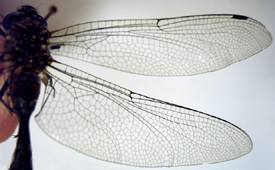 |
| 2' |
Two antenodal crossveins; wings stalked at base, either hyaline or lightly tinged with brown (rarely black); qudrangle without crossveins |
|
3 |
 |
| 3' |
M3 and Rs arising nearer nodus than arculus, usually arising below nodus; wings usually held together at rest |
|
4 |
 |
| 4(3') |
Anal vein and Cu2 long, reaching level of nodus; quadrangle distinctly trapezoidal |
|
Coenagrionidae |
 |
| 6(1') |
Triangles in front and hind wings similar in shape, about equidistant from arculus; most costal and subcostal crossveins not in line; usually a brace vein (an oblique crossvein) present behind proximal end of pterostigma |
|
7 |
 |
| 6' |
Triangles in front and hind wings usually not similar in shape, triangle in front wing farther distad of arculus than trianle in hind wing; most costal and subcostal crossveins in line; no brace vein behind proximal end of pterostigma |
|
10 |
 |
| 7' |
Brace vein present behind proximal end of pterostigma; eyes either broadly contiguous by more than width of lateral ocellus or widely separated |
|
8 |
  |
| 8(7) |
Compound eyes contiguous on dorsum of head for a distance greater than width of lateral ocellus |
|
Aeshnidae |
 |
| 10' |
Hind margin of compound eyes straight; males without small lobe on side of second abdominal segment; inner margin of hind wing of male not notched; anal loop with inner margin of "toe" usually well developed |
|
Libellulidae |
 |
| |
|
|
|
|
| 1' |
Front legs not enlarged and modified for digging, or if they are slightly enlarged (Tridactylidae) the front and middle tarsi are 2-segmented and the insect is less than 10 mm in length |
|
2 |
 |
| 2' |
Tarsi 3- or 4-segmented, or if front and middle tarsi are 2-segmented (Tetrigidae), then hind tarsi are 3-segmented; front legs not dilated; abdomen with a single pair of cerci; length usually over 10 mm |
|
3 |
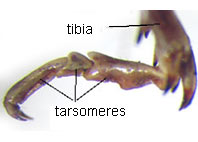  |
| 3(2') |
Hind tarsi 3-segmented, front and middle tarsi 2- or 3-segmented; ovipositor short; antennae usually short, seldom more than half as long as the body; auditory organs (tympana), if present, on sides of first abdominal segment |
|
4 |
   |
| 3' |
Tarsi 3- or 4-segmented; ovipositor usually elongate; antennae long, usually as long as body or longer; auditory organs, if present, at base of front tibiae. |
|
8 |
 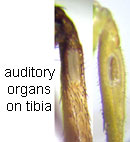  |
| 4(3) |
Pronotum prolonged backward over abdomen and tapering posteriorly; front wings vestigial; no arolia; front and middle tarsi 2-segmented, hind tarsi 3-segmented |
|
Tetrigidae |
  |
| 4' |
Pronotum not prolonged backward over abdomen; front wings usually well developed if hind wings are present; arolia present; all tarsi 3-segmented |
|
5 |
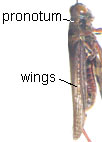  |
| 5' |
Antennae longer than front femora; wings nearly always present; size variable, but usually over 15 mm in length; widely distributed |
|
6 |
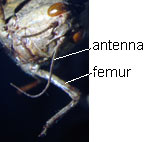  |
| 6(5') |
Wings and tympana nearly always present; antennae not unusually long; males without a file on third abdominal tergum; widely distributed |
|
7 |
  |
| 7' |
Hind tibia with only the inner immovable spine at apex, outer one absent; prosternum with or without median spine or tubercle |
|
Acrididae |
 |
| 8(3') |
All tarsi 3-segmented; ocelli present or absent; ovipositor cylindrical or needle-shaped |
|
9 |
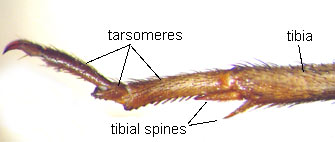 |
| 8' |
At least middle tarsi, and usually all tarsi, 4-segmented; ocelli usually present; ovipositor sword-shaped |
|
11 |
 |
| 9' |
Wings present; hind femora not greatly enlarged; eyes not small and ocelli present; not 2-4 mm in length; not found living in ant nests |
|
10 |
  |
| 10' |
Wings usually well developed; hind tibiae nearly always with long spines; body not covered with scales; hind femora only moderately enlarged; widely distributed |
|
Gryllidae |
  |
| 11(8') |
Wings usually absent, but if present, then with 8 or more principal longitudinal veins; males lacking stridulatory sturctures on front wings; front tibiae with or without tympana; color usually gray or brown |
|
12 |
 |
| 11' |
Wings present (but sometimes very small) and with fewer than 8 principal longitudinal veins; males with stridulatory structures on front wings; front tibiae with tympana; color variable but often green |
|
15 |
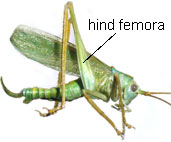  |
| 12(11) |
Antennae contiguous at base or nearly so |
|
Raphidophoridae |
 |
| 15' |
Antennal sockets located near top of head; wings and ovipositor variable; hind femora usually extending beyond apex of abdomen |
|
Tettigoniidae |
  |
| |
|
|
|
|
| 1 |
Beak arising form back of head or apparently from between front coxae; antennae variable (bristlelike or with more than 5 segments); front wings of uniform texture throughout, held roof-like over abdomen, tips not or but slightly overlapping |
|
2 |
 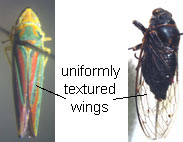 |
| 1' |
Beak arising from front part of head; antennae 4- or 5-segmented, not bristlelike; front wings (if present) usually thickened at base, membranous apically, the membranous portions overlapping at rest; hind wings uniformly membranous (suborder Heteroptera) |
|
3 |
 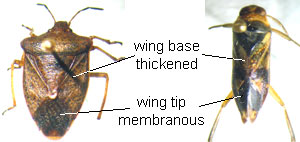 |
| 2(1) |
Antennal flagellum short, bristlelike; beak arising from back of head; tarsi 3-segmented; active, free-living insects (suborder Auchenorrhyncha) |
|
65 |
  |
| 2' |
Antennae usually long and filiform, with evident segmentation; beak, when present, arising between front coxae; tarsi (when legs are present), arising between front coxae; often not active insects (suborder Sternorrhyncha) |
|
81 |
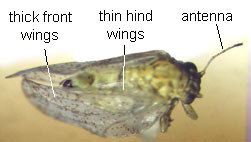  |
| 3' |
Compound eyes present |
|
6 |
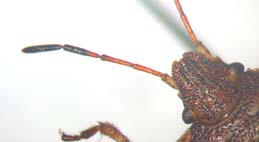  |
| 6(4') |
Antennae shorter than head, usually hidden in cavities beneath eyes; no arolia; aquatic or semiaquatic |
|
7 |
 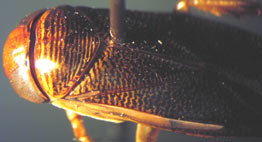 |
| 6' |
Antennae as long as or longer than head, usually free and visible from above; arolia present or absent; habits variable |
|
14 |
 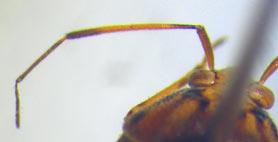 |
| 7' |
Ocelli absent; size variable; aquatic species |
|
9 |
  |
| 9(7') |
Front tarsi 1-segmented and modified into scoop-shaped structures; beak very short and hidden, appearing 1-segmented; dorsal surface of body usually with fine, transverse lines |
|
Corixidae |
  |
| 9' |
Front tarsi not 1-segmented and modified into scoop-shaped structures; beak segmentation clearly evident; dorsal surface of body without fine, transverse lines |
|
10 |
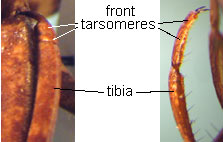  |
| 10' |
Body wihout elongate terminal filaments or, at most, with short ones; tarsi variable |
|
11 |
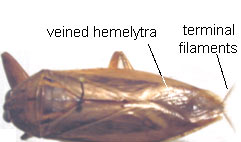 |
| 11(10') |
Hind legs long and oarlike; hind tarsi without claws; length 5-16 mm |
|
Notonectidae |
 |
| 11' |
Hind legs not unusually lengthened; hind tarsi with claws; length variable |
|
12 |
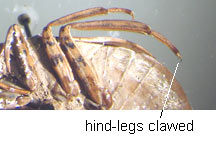 |
| 12' |
More than 3 mm long, often more than 20 mm; not strongly convex; front legs raptorial with femora thickened |
|
13 |
  |
| 13(12') |
Membrane of hemelytra with veins; abdomen with short terminal filaments; length over 20 mm |
|
Belostomatidae |
 |
| 14' |
Body of various forms, but if linear, then head shorter than thorax and the insect terrestrial |
|
15 |
 |
| 15(14') |
Tarsal claws, especially on front legs, ante-apical; apex of last tarsal segment more or less cleft; aquatic, surface inhabiting |
|
16 |
 |
| 15' |
Tarsal claws apical; apex of last tarsal segment entire |
|
17 |
|
| 16(15) |
Middle legs arising closer to hind legs than to front legs; hind femora extending well beyond apex of abdomen; all tarsi 2-segmented; ocelli present but small; usually over 5 mm long |
|
Gerridae |
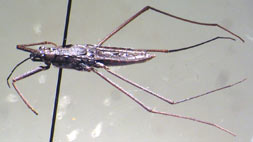  |
| 17(15') |
Antennae 4-segmented |
|
20 |
 |
| 17' |
Antennae 5-segmented |
|
64 |
 |
| 20(19') |
Ocelli present |
|
21 |
 |
| 20' |
Ocelli absent |
|
51 |
 |
| 21' |
Tarsi, at least on hind legs, 3-segmented |
|
26 |
 |
| 26 |
Antennal segments similar, not with 2 short and thick basal segments, third and fourth segments not very slender; tarsi and size variable |
|
30 |
 |
| 30' |
Hemelytra without a cuneus; size variable |
|
34 |
 |
| 34' |
Beak 4-segmented |
|
37 |
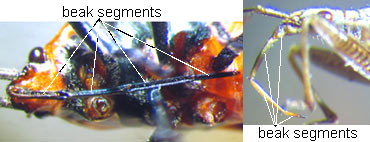 |
| 37(36') |
Distal ends of front and middle tibiae with broad, flat apical process; arolia absent; membrane of hemelytra (when developed) with numerous marginal cells |
|
Nabidae |
  |
| 37' |
Distal ends of front and middle tibiae without such a process; arolia present; membrane of hemelytra variable |
|
41 |
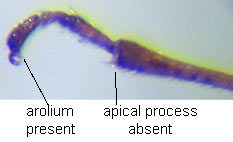 |
| 41(40') |
Spiracles on abdominal segments 2-7 all located dorsally |
|
Lygaeidae |
 |
| 51' |
Tarsi 2- or 3-segmented; beak 3- or 4-segmented; front legs usually not raptorial; size, shape , color variable |
|
52 |
  |
| 52' |
Beak long, 3- or 4-segmented; not fitting into groove in prosternum; front femora and head variable |
|
53 |
 |
| 53(52') |
Beak 3-segmented; wings vestigial; ectoparasites of birds and mammals |
|
Cimicidae |
 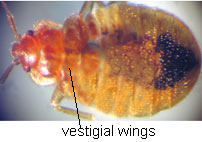 |
| 53' |
Beak 4-segmented (only 2-3 segments can be seen in some Aradidae); wings usually well developed |
|
54 |
 |
| 54(53') |
Hemilytra with cuneus, the membrane with 1 or 2 closed cells, rarely with other veins; rarely membrane is absent, in which case cuneus lacking; hind femora enlarged; mesosternum and metasternum formed of more than 1 sclerite |
|
Miridae |
 |
| 64' |
Tarsi 3-segmented; sternum of thorax usually without median longitudinal keel |
|
Pentatomidae |
 |
| 65' |
Antennae not separated from front of head by a vertical carina, thus arising on front of head between eyes; tegulae usually absent, no Y-vein in anal area of front wing |
|
76 |
 |
| 76(65') |
Three ocelli; large insects with membranous front wings; males usually have sound-producing organs ventrally at base of abdomen; not jumping insects |
|
Cicadidae |
  |
| 76' |
Two (rarely 3) ocelli or none; smaller insects, sometimes with front wings thickened; sound-producing organs generally absent; usually jumping insects |
|
77 |
 |
| 77' |
Pronotum not extending back over abdomen, the scutellum nearly always well exposed; hind tibiae with or without distinct spurs or spines |
|
79 |
 |
| 79(77') |
Hind tibiae with 1 or more rows of small spines; hind coxae transverse |
|
Cicadellidae |
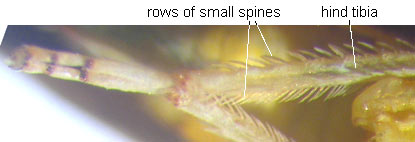 |
| 79' |
Hind tibiae without spines or with 1 or 2 stout ones laterally and a crown of short spines at tip; hind coxae short and conical |
|
80 |
 |
| 80' |
Hind tibiae with 1 or 2 stout spines laterally and a crown of short spines at tip; head usually not largely covered by pronotum, the face slanting backward; beak length variable; widely distributed |
|
Cercopidae |
 |
| 81(2') |
Tarsi 2-segmented, with 2 claws; winged forms with 4 wings; mouthparts usually well developed in both sexes, with beak long |
|
82 |
  |
| 82(81) |
Antennae with 5-10 (usually 10) segments; front wings often thicker than hind wings; jumping insects |
|
Psyllidae |
 |
| 82' |
Antennae with 3-7 segments; wings membranous or opaque whitish; not jumping insects |
|
83 |
  |
| 83' |
Wings membranous and not covered with whitish powder; hind wings much smaller than front wings; cornicles often present |
|
84 |
  |
| 84(83') |
Front wings with 4 or 5 (rarely 6) veins behind stigma extending to wing margin (Rs present); cornicles usually present; antennae generally 6-segmented; sexual females oviparous, parthenogenetic females viviparous |
|
Aphididae |
  |























































































































